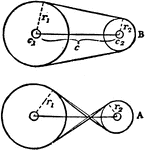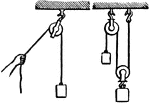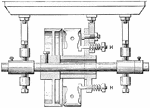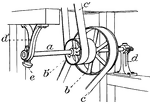Clipart tagged: ‘pulleys’
Conveyer Belt
A belt conveyor consists of two or more pulleys, with a continuous loop of material, the conveyor belt…

Pulley
Two arrangements of pulley: crossed belt and uncrossed belt. The pulleys are constructed with two circles…

Pulley
"In the single fixed pulley (fig. 1) there is no mechanical advantage, the power and weight being equal.…

Pulley
"In a system of pulleys (figs. 3,4) in which the same string passes round any number of pulleys, and…

Pulley
"In a system in which each pulley hangs by a separate cord and the strings are parallel (fig. 5), there…

Loose Driving Pulley
"The belt is thrown on to set the machine in motion, the loose pulley is pressed aside by the spiral…

Pulleys - Smeaton's Blocks
"A system of pulleys in two blocks, so arranged that the parts of continuous rope are approximately…

Shafting
"In machinery, the system of shafts which connects machinery with the prime mover, and through which…
Shoe Block
"Nautically, a block with two sheaves, whose axes are at right angles to each other, used for the buntlines…